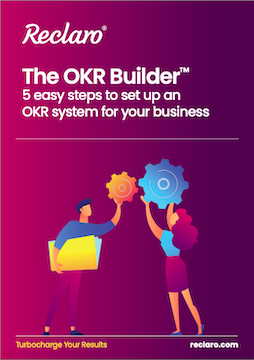
Last updated 25 June 2021 ·

Introducing OKRs can be transformational for any business but only if they are set correctly, cascaded effectively and firmly embedded into the culture of an organisation. OKRs work most effectively when all teams use a consistent framework, adapting the objectives and key results set at a leadership level and breaking these down into role-specific OKRs that various teams and individuals can action, according to their area and level of specialism.
Check out our blog on why OKRs fail to find out the most common reasons OKRs may not work in an organisation. One of these is, of course, setting and forgetting! Some companies simply set and forget their core values and objectives, leaving them stored on a shelf to gather dust. Once they’re set, they think ‘great, that’s done,’ and move on. The same can, of course, happen with OKRs if implemented very loosely at an individual level without full company buy-in. However, success requires the CEO to set OKRs and then cascade these throughout all teams within the business, embedding the idea of setting and working towards goals into the organisational culture and continually tracking progress. This avoids OKRs becoming a ‘set and forget’ exercise. They need to remain front of mind for everyone in the business, day to day and week to week.
OKRs are not New Year’s Resolutions; they should be set with careful consideration of the business vision and form a solid action plan to achieve that.
Top 10 Tips
Here are 10 tips on how to set and not forget OKRs in your business:
- Before introducing OKRs into your business, educate employees on what they are and why they are necessary as better understanding leads to improved adoption.
- Once the CEO and leadership level OKRs have been set and cascaded throughout the rest of the business, ensure you allow enough time for the wider teams to digest these OKRs and create their own.
- Work with employees to ensure the OKRs they set are specific, measurable, timely, achievable and inspiring so they are set up for success.
- Communicate the business vision effectively - include it (maybe a shortened version) on all internal communications to centralise focus and keep it top of mind amongst all teams in the business.
- Include OKR performance reporting in weekly/monthly team meetings or even wider company briefings.
- Make OKRs a structured part of regular 121’s and employee performance reviews.
- Embed OKR terminology into everyday life within your organisation by getting the Senior Leadership Team to set the pace, leading by example.
- Introduce an internal awards scheme for those who regularly perform well and achieve their OKRs to celebrate their success.
- Introduce a leaderboard showing live performance data relating to OKRs to generate healthy competition and appeal to the most ambitious employees.
- Identify a standardised method of communicating OKRs throughout the business, in which performance can be logged and regularly updated as teams take action to achieve their goals.
OKRs aren’t a linear process. In fact, they operate in a cyclical rhythm. They are set at the CEO level and cascaded throughout the business. Teams become aligned and work more effectively towards transparent goals, ultimately achieving the desired business results. As mentioned earlier, the true nature of OKRs requires them to be specific, measurable, timely, inspiring and achievable (with stretch). This makes it easier to monitor performance throughout the set time period. Once your OKR deadline draws near, it’s essential to evaluate performance and make any necessary adjustments for the next time block before you set off once again, working hard to achieve exceptional results in your business. As with most things, adopting OKRs is a learning process that requires constant evaluation and optimisation to improve and make progress.
Check out our blog, OKR examples to help you get started for further advice and guidance on setting CEO level OKRs with real-life examples.
You may want to consider using OKR software to help set and cascade your CEO level OKRs throughout your business to ensure effective communication of the key priorities required to achieve your vision. The 1-3-5® performance system is an OKR framework that requires you to set 1 crystal clear vision, 3 mission-critical objectives and 5 key results per objective. Once set, the software updates in real-time as employees mark actions as completed, giving you an accurate view of full team performance all in one simple dashboard. For more information, visit our page explaining how it works.
To assess whether OKRs are right for your business, check out our blog OKR you ready to raise your game?






